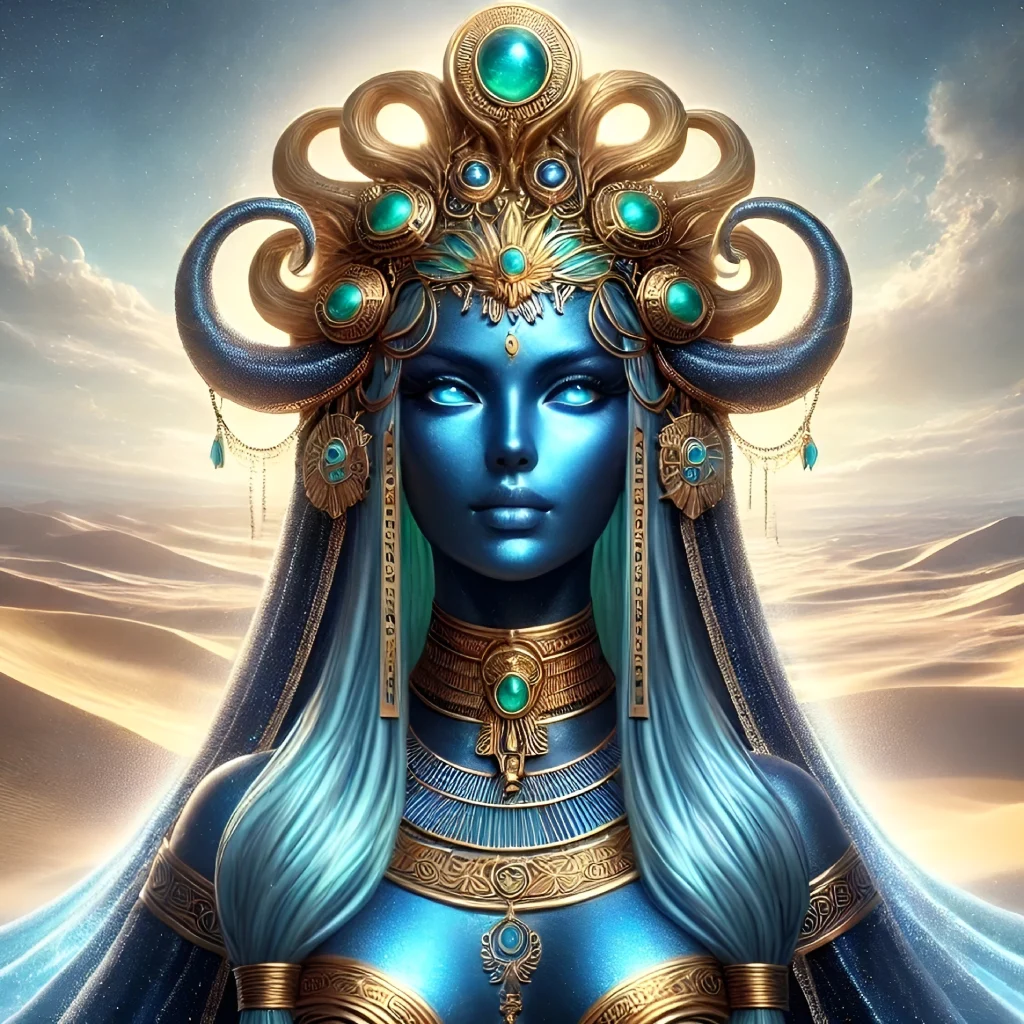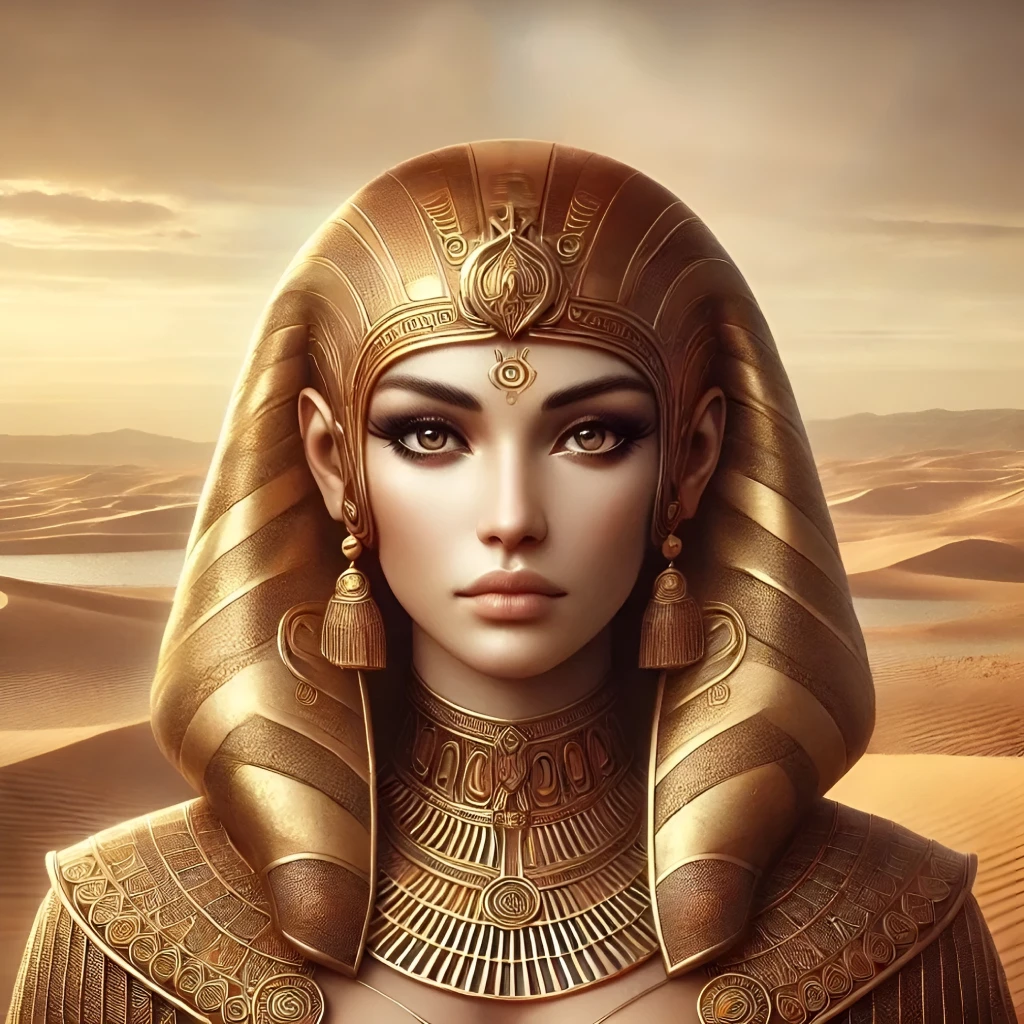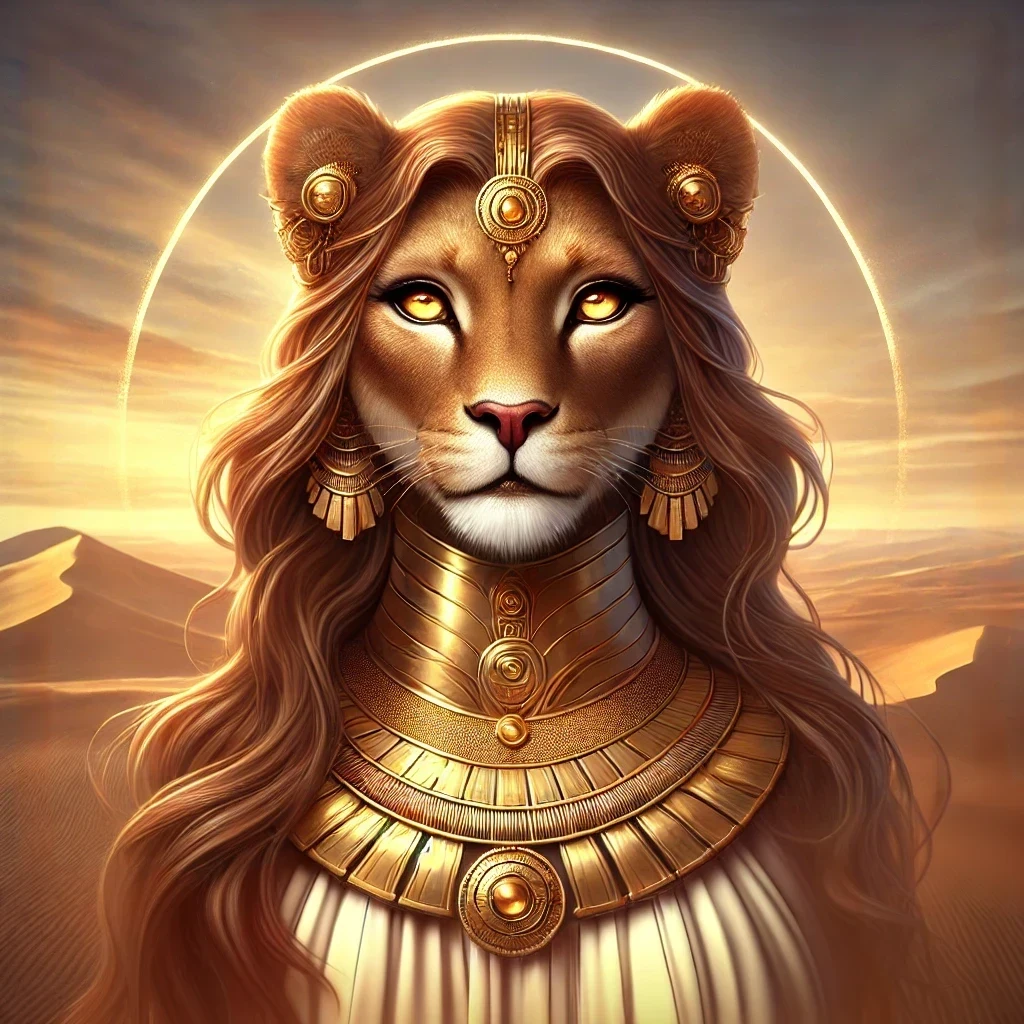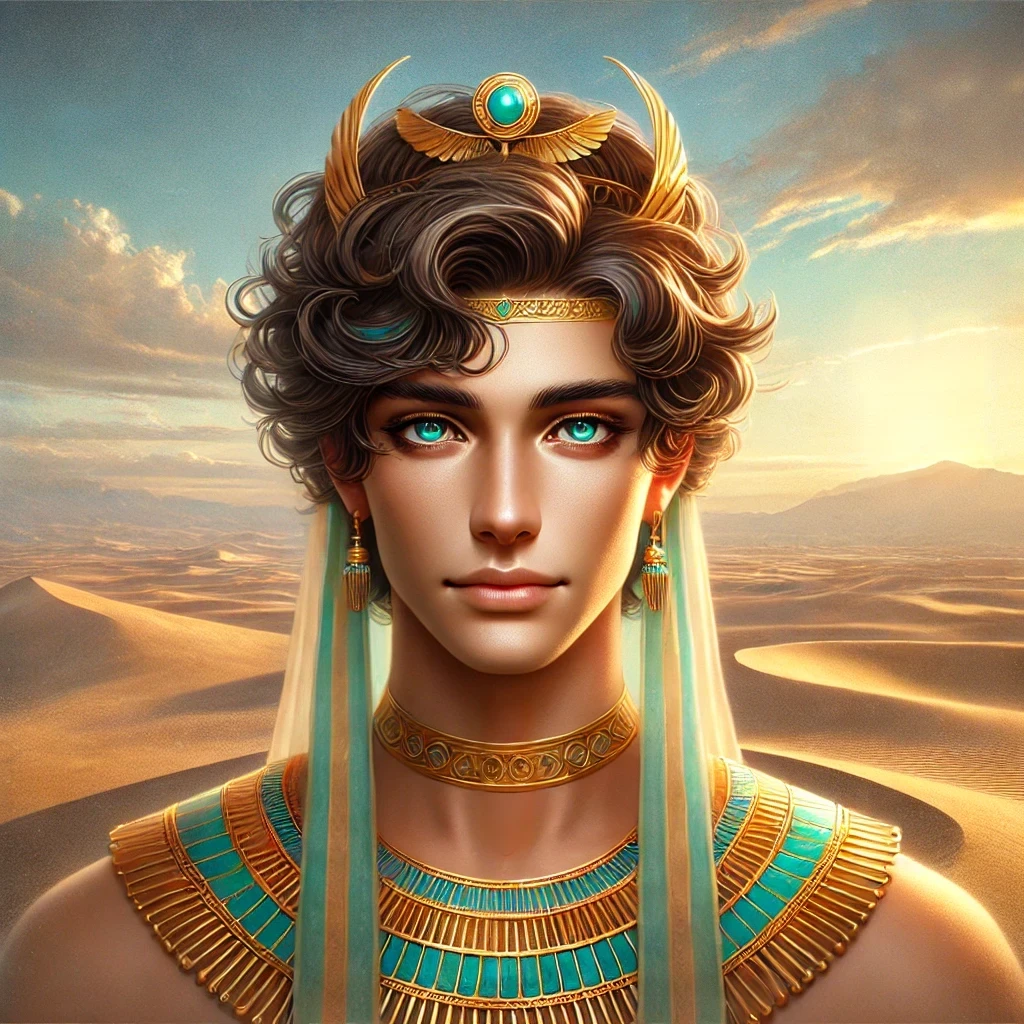Naunet is an ancient Egyptian deity associated with the primordial waters of creation. Her name derives from the Egyptian word Nun, signifying the boundless, formless abyss that preceded the cosmos. As a counterpart to Nun, she embodies the feminine aspect of the primordial waters. She holds a vital place in the Ogdoad, a group of eight deities central to Hermopolitan cosmology. Unlike the more anthropomorphized gods of later periods, she remained an abstract, enigmatic presence—one that shaped the very foundation of existence.
Origins
The Ogdoad of Hermopolis
Naunet belongs to the Ogdoad, a set of eight deities representing the fundamental forces of pre-creation. The Ogdoad consisted of four male-female pairs embodying concepts such as darkness, hiddenness, infinity, and primordial water. Alongside Nun, she formed the primordial abyss from which the first mound of creation emerged. Their presence is documented in texts dating back to the Old Kingdom, though their theological framework likely predates written records.
Early References and Evolution
While explicit mentions of Naunet are sparse, her existence is inferred from Pyramid Texts and later inscriptions. Unlike her male counterpart, she rarely appears independently. As Egyptian theology evolved, she became increasingly obscure, overshadowed by personified goddesses of water and fertility like Tefnut and Mehet-Weret. Some scholars speculate that Naunet’s role was absorbed into other deities, while others believe her presence endured in an esoteric form within temple rites.
Connection to Cosmic Origins
The Ogdoad’s role as the progenitors of creation positioned Naunet as a key component of Egyptian cosmology. While she did not actively shape the cosmos, she was intrinsic to the existence of the watery void from which creation sprang. The primordial waters, often depicted as both infinite and containing the potential for all things, underscore her importance in sustaining the Egyptian worldview of cyclical renewal.
Appearance
Serpent and Aquatic Imagery
Iconography of Naunet is scarce, but when depicted, she often takes the form of a serpent or a woman with a snake-like body. This aligns with the association of primordial deities with serpentine and amphibian imagery, symbolizing chaos and unformed potential.
Connection to the Celestial Waters
In some artistic interpretations, she appears supporting the sky, reinforcing her connection to the unseen waters that sustained the heavens. This aligns with broader Egyptian beliefs where celestial bodies floated upon an invisible ocean.
Variability in Representation
Unlike more anthropomorphic deities, Naunet’s depictions varied significantly. Some sources suggest that she took on a hybrid form, combining attributes of snakes, frogs, or water-dwelling creatures. Her portrayal as an abstract force rather than a fully individualized deity further emphasizes her mysterious and formless nature.
Abilities
The Embodiment of the Primordial Abyss
Naunet’s primary role was to embody the endless waters that predated creation. She, along with her consort, represented the vast, undifferentiated state of the cosmos before the emergence of order.
Sustaining the Cosmic Balance
Though rarely portrayed as an active force, her presence was crucial in maintaining Ma’at—the cosmic order. By containing the chaotic waters, she helped sustain the structure of the universe, ensuring the cycle of life continued uninterrupted.
Influence on Later Theological Concepts
As Egyptian religious thought evolved, Naunet’s association with the abyss continued to influence later depictions of chaos and rebirth. The concept of Nun’s waters threatening to consume creation was a persistent theme, reflecting the belief that the cosmos remained in delicate balance.
Domain
The Primeval Waters
As the feminine counterpart to Nun, she ruled over the dark, featureless waters from which all things emerged. These waters were both a source of life and a symbol of the unstructured potential that preceded creation.
The Underworld and Hidden Realms
While she was not a chthonic deity in the traditional sense, her connection to the abyss linked her to hidden aspects of existence. The unseen depths of the earth and the mysteries beyond mortal comprehension were tied to her domain.
Continuity in the Cycle of Creation
Egyptian belief saw the universe as perpetually oscillating between order and chaos. Naunet’s presence in this cycle reinforced the notion that creation itself was a temporary triumph over primordial waters that never truly disappeared but instead lingered just beyond the visible world.
Myths
The Role in the Creation Narrative
Although the Ogdoad played a role in Egyptian creation myths, they were not often the central actors. Instead, they prepared the cosmos for the emergence of Ra, the sun god. The chaotic waters they represented receded to make way for the first landmass and the dawn of existence.
Connection to Later Cosmologies
Though myths directly involving Naunet are rare, her conceptual presence persisted in later theological developments. Elements of her role reappeared in stories of the Nun’s waters threatening to engulf creation, reinforcing the ever-present potential for chaos.
Naunet in Esoteric Texts
Later religious texts, particularly those emphasizing the cyclical nature of existence, reference a primordial feminine force akin to Naunet. Though rarely named outright, her influence can be detected in references to hidden waters that continue to nourish creation from the unseen realms.
Symbolism
The Feminine Aspect of Chaos
Naunet symbolized the hidden, passive aspect of the primordial state. While Nun embodied the active force, she represented the latent potential within the abyss.
The Serpent as a Symbol
The serpent motif in her depictions linked her to regeneration and eternity. Snakes shed their skin, symbolizing cycles of renewal—an idea that resonated with the eternal nature of the waters she embodied.
Water as the Womb of Creation
As a primordial deity, Naunet was often associated with the amniotic, life-giving aspects of water. This connection reinforced the idea that all life sprang from the boundless, nurturing abyss she represented.
Worship
The Temple of Hermopolis
As part of the Ogdoad, Naunet was venerated in Hermopolis, where the cult of Thoth was dominant. Though she lacked independent temples, her presence was acknowledged in ritual practices.
Rituals and Offerings
Worship of primordial deities was more abstract than that of popular gods like Isis or Osiris. Offerings of water, symbols of the abyss, and invocations during funerary rites were likely forms of veneration.
Decline of Worship
As Egyptian religion shifted focus toward more personal deities, reverence for primordial figures waned. Their influence persisted in theological texts but faded from active cult practices.
Associations
Nun: Her Primordial Consort
Naunet was inextricably linked to Nun, forming a complementary duality within the Ogdoad. While Nun often received more recognition, she remained an integral aspect of this pairing.
The Ogdoad’s Collective Role
Together with Amun and Amaunet, Kuk and Kauket, and Huh and Hauhet, she represented the fundamental oppositional forces sustaining the cosmos.
Links to Later Goddesses
Though distinct from fertility goddesses, she shared symbolic overlaps with Neith and Tefnut, both of whom held watery associations in certain myths.
Legacy
Influence on Later Thought
Naunet’s conceptual presence endured in philosophical interpretations of creation. The notion of a primordial sea remained influential in Egyptian and later Hellenistic thought.
Rediscovery and Modern Interest
While largely absent from mainstream religious texts, her role has attracted scholarly interest in modern Egyptology. Researchers explore how early Egyptian cosmology influenced later religious traditions.
Enduring Mystique
Unlike the major deities of Egyptian mythology, Naunet never transitioned into a widely venerated figure. However, her existence as a fundamental force of creation cements her place in the grand cosmological structure of ancient Egypt.
Trivia
- Naunet and the Moon: Some scholars suggest a link between Naunet and lunar cycles, though evidence remains speculative.
- The Ogdoad’s Hidden Names: In certain texts, Ogdoad deities were considered too sacred to name directly.
- Naunet’s Absence in Personal Worship: Unlike Isis or Hathor, she was never an object of household devotion.
- Connection to Chaos Serpents: Some myths hint at similarities between Naunet and Apophis.
- Underworld Guardian?: Some texts imply she played a role in the Duat, Egypt’s underworld.
- Parallel in Mesopotamian Myths: Naunet’s concept is similar to Tiamat in Babylonian tradition.
- Influence on Gnostic Texts: Some early Gnostic beliefs drew from Egyptian primordial water myths.
- Rare Depictions: She appears in fewer than ten known surviving temple reliefs.
- Sky and Ocean Duality: She was sometimes seen as holding up both the sky and the deep waters.
- Symbolic Numbers: The Ogdoad’s association with eight was sacred in Egyptian numerology.



